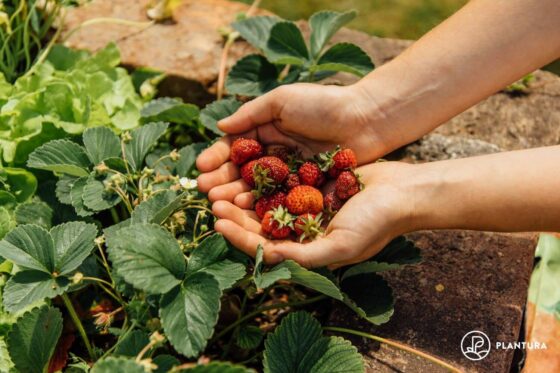Awọn akoonu
Garden strawberries (strawberries) require 3 top dressings per season: in early spring – with nitrogen, in early August – with phosphorus, but during flowering it needs complex top dressing.
How to feed strawberries during flowering
The classic top dressing recommended by professional agronomists is nitrophoska: 1 tbsp. spoon for 10 liters of water. The fertilizer must be stirred well so that it dissolves completely, and then water the strawberries under the root. Norm – 1 bucket (10 l) per 1 sq. m.
Nitrophoska contains 11% nitrogen, 10% phosphorus and 11% potassium – that is, all the main nutrients that ensure growth, active flowering and fruiting. And it can be used on all types of soil (2).
In principle, this top dressing is enough for strawberries, but summer residents often feed it additionally.
Please note that the fertilizer must be precisely complex. It is dangerous to apply nitrogen in its pure form under strawberries. The mineral forms of this element allow you to grow larger berries, but their taste becomes worse. But most importantly, mineral nitrogen fertilizers lead to the accumulation of nitrates in fruits (1).
Boric acid
Boron is a micronutrient. It is necessary for strawberries for normal growth and development, but very little is required.
– As a rule, this element is sufficient in the soil, plants rarely suffer from its shortage, – says agronomist-osin Svetlana Mihailova. But there are soils where it is scarce. For example, sod-podzolic and forest. There is little boron in sandy soils – it is quickly washed out from there. On them, top dressing with boric acid will not be superfluous.
Strawberries are fed with boron during flowering – it stimulates the formation of flowers, and consequently, the yield increases.
The most effective foliar top dressing with boron, that is, if they spray strawberries on the leaves. But! Boron is a very toxic element, it has carcinogenic properties, so it is important that it does not enter the body with fruits. And this is not easy, because if you overdo it with concentration, it will definitely accumulate in strawberries. In this regard, it is much safer to feed at the root – the plant will not take extra boron from the soil. However, the effect of such dressings is lower.
The rate of application of boron when fertilizing under the root is as follows: 5 g (1 teaspoon) of boric acid per 10 liters of water. It must be dissolved in water, preferably warm, and then water the plants – 10 liters per 1 sq. m.
For foliar top dressing, 5 g of boron is diluted in 20 liters of water, that is, the concentration should be 2 times less than when watering.
Iwukara
There are constant disputes about feeding strawberries with yeast: someone considers it effective, someone is meaningless.
There is no scientific data on the effect of yeast on plant growth and development, as well as on yield. No serious reference book recommends such top dressing.
We can definitely say that yeast is not a fertilizer – it is rather a dietary supplement for plants. It is believed that they stimulate the growth of soil microorganisms and help them decompose organic residues faster. However, the yeast itself, during reproduction, takes a lot of potassium and calcium from the soil, so they can harm – the soil is depleted very quickly. That is, in fact, yeast become competitors of plants for nutrition.
But if you still have a desire to experiment, it is important to remember: yeast can only be added together with organic matter and ash – these fertilizers will help make up for the lack of elements.
The traditional recipe for feeding yeast looks like this: 1 kg of yeast (fresh) per 5 liters of water – they need to be mixed well so that they dissolve completely. Strawberries should be watered at the rate of 0,5 liters per bush.
Ash
Ash is a natural fertilizer that contains two main macronutrients: potassium and phosphorus.
– In birch and pine firewood, for example, 10 – 12% potassium and 4 – 6% phosphorus, – says agronomist Svetlana Mikhailova. – These are very good indicators. And strawberries are just responsive to potassium and phosphorus – they are responsible for flowering and crop formation. Therefore, ash for strawberries is an excellent fertilizer.
Ash is best applied directly under the plants, about 1 handful per bush – it must be evenly scattered over the surface of the soil, and then watered.
Gbajumo ibeere ati idahun
We addressed questions about feeding strawberries during fruiting agronomist-osin Svetlana Mikhailova.
Do I need to feed strawberries with potassium permanganate?
If necessary, it is better to add manganese superphosphate or manganese nitrophoska.
Is it possible to make manure under strawberries?
Is it possible to make humus on strawberries?
Awọn orisun ti
- Labẹ ifarahan ti Tarasenko MT Strawberries (ti a tumọ lati Gẹẹsi) // M .: Ile-itumọ ti awọn iwe-iwe ajeji, 1957 - 84 p.
- Mineev V.G. Agrochemistry. Textbook (2nd edition, revised and enlarged) // M.: MGU Publishing House, KolosS Publishing House, 2004.– 720 p.










